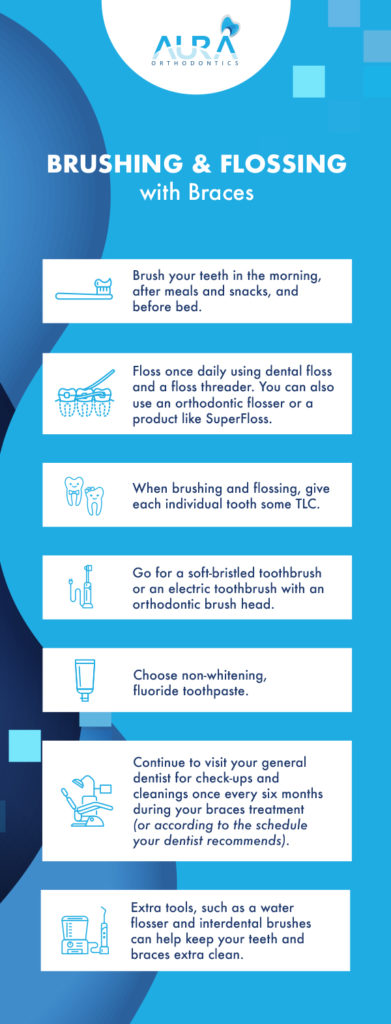
If you recently got braces put on, or you’re planning to soon, you’re probably feeling pretty thrilled about the prospect of straighter teeth. But with a new set of hardware bonded to your pearly whites, you might also be a bit perplexed about how to brush your teeth with braces. And, what about flossing? How do you get around the brackets and wires?
Of course, when you visit Aura Orthodontics for braces in Surrey or Langley, BC, we’ll fill you in on everything you need to know about brushing and flossing during treatment. However, if you got caught up in the excitement and forgot some of the finer points, or you haven’t kicked off treatment yet and want to know what to expect, we have you covered.
In this post, we’ll talk about:
- Why oral hygiene is so important when you have braces
- How often you should be brushing and flossing during treatment
- How to brush your teeth with braces
- How to floss your teeth with braces
- The extra tools to consider for super clean teeth
- The best toothbrush, toothpaste and mouthwash for braces
- And, finally, a few additional pro tips for maximum smile health

Why is Oral Hygiene So Important When You Have Braces?
When you have braces, the brackets and wires can trap food and plaque. If not regularly brushed away, this makes you more susceptible to cavities and gum disease. In extreme cases, you could have to have your braces removed in order to receive dental treatment.
If you’re wondering what happens to teeth after braces without brushing, check out our previous post on braces stains. The most common type of stain shows up as white spots on the teeth around where your brackets were. These white spots are the result of decalcification, which is when the acids in plaque cause the enamel to lose minerals, resulting in early decay. The majority of cases are caused by poor oral hygiene and plaque build-up during braces treatment.
Aside from cavities, gum disease, and white spots, skipping brushing and flossing can increase the length of your treatment. This is because your teeth move most efficiently when your mouth is healthy.
How Often Should You Brush and Floss During Braces Treatment?
How often should you brush your teeth with braces? We recommend brushing in the morning, after meals and snacks, and before bed. For most patients, this means brushing about five times a day. As for how long to brush your teeth with braces, you’ve probably heard you should always brush for at least two full minutes. However, since you’re working around your hardware, it may be closer to three minutes a session.
Be sure to floss once daily as well. We know there’s some debate about whether to floss or brush first and, truthfully, we’re happy as long as you floss, regardless of the order. But, if you can, floss before you brush. According to a study in the American Journal of Periodontology, flossing before brushing removed significantly more plaque than flossing after brushing and, as you know, plaque removal is the name of the game when you have braces.
How Do You Brush Your Teeth When You Have Braces?
If you’re a visual learner, the Canadian Association of Orthodontists has a helpful guide on how to brush your teeth with braces or watch our video on the topic starring our very own Dr. Vishal Sharma.
Here are the basics:
- To make things easier, let’s pretend you’re starting with your top teeth. Hold your toothbrush so that it’s facing your brackets straight on. Brush each bracket using small circular motions.
- Next, hold your toothbrush at an angle so that the bristles are positioned under the bottom of your braces brackets, facing up towards your nose. Gently tease the bristles between your brackets and wires and wiggle the toothbrush back and forth as you brush.
- Hold your toothbrush at an angle again, but this time with the bristles facing down, and brush the top of your brackets with that same wiggling motion.
- Brush along your gumline and then brush the chewing and inside surfaces of each tooth, as well as the sides of the back molars.
- Repeat the process on your bottom teeth.
- Give each tooth individual attention and finish up by brushing your tongue.
How Do You Floss Your Teeth When You Have Braces?
Flossing with braces can be tricky at first, but once you get the hang of it, you’ll be able to do it quickly. There are several different types of floss for braces. You can use regular dental floss and a floss threader, which is the cheapest option. However, you will have to rethread the floss every time you move on to the next pair of teeth, so this method takes the longest.
You can also use a floss-like Oral-B SuperFloss, which has a built-in floss threader. This will save time. Or you can use an orthodontic flosser, such as a Platypus flosser. The floss pick is designed to easily fit under the wires of your braces and is the fastest way to floss with braces.
How to Floss With Braces Using a Floss Threader
- Tear off a piece of waxed dental floss (unwaxed floss will get shredded by your hardware) about 12-18 inches long.
- Thread a bit of the dental floss through the loop at the end of your floss threader. Pinch it with your fingers so it doesn’t fall out when you use it.
- Guide the pointed end of your floss threader between two brackets and under your braces wire. Keep going until you’re able to grab the dental floss with your other hand.
- With the dental floss under the wire, position it between your teeth.
- Floss up and down the side of one tooth, getting just under the gumline, and then floss up and down the side of the other tooth.
- Pull the floss out and re-thread it, repeating the process until you’ve flossed your entire mouth.
How to Floss Using SuperFloss
- Run the stiffened end of your SuperFloss between your brackets and under your braces wire.
- Once it’s under the wire, position the floss between your teeth.
- Floss up and down the side of one tooth, getting under the gumline, and then up and down the side of the neighboring tooth.
- Pull the floss out and then maneuver it under your wire and between the next pair of teeth.
- Repeat the process until you’ve flossed your entire mouth.
- Pro tip: You can use the spongy part of the SuperFloss to effectively clean in between teeth that have larger spaces.
How to Floss With Braces Using an Orthodontic Floss Pick
- Position the floss pick so that the thinner side is on the outside of your teeth, pointing out towards your lips.
- Guide the thin side under the wire and position the floss between your teeth.
- Floss up and down the side of one tooth, getting under the gumline, and then floss up and down the side of the other tooth.
- Repeat this process until your entire mouth is flossed.
What Extra Tools Should I Use to Keep My Braces Clean?
In addition to brushing and flossing, there are some extra oral hygiene tools you’ll want to consider adding to the mix during your braces treatment. The two that we highly recommend to our Langley and Surrey braces patients are:
- An Interdental Brush – An interdental brush, also known as an interproximal brush or proxy brush, looks like a teeny tiny bottle cleaner. These brushes may be small, but they pack a lot of plaque-fighting power.
They’re designed to fit into tight spaces and are helpful for cleaning the hard-to-reach areas around your brackets. Use your proxy brush once or twice a day before brushing with your regular toothbrush. You might also want to bring some with you on the go since they’re great for dislodging food stuck in your braces.
- A Waterpik – Investing in a Waterpik for braces is also a good idea if it’s in your budget. A Waterpik, or water flosser, can remove stubborn plaque and food that you missed when brushing and flossing. It encourages healthy gums and leaves your braces and teeth feeling exceptionally clean.
The thing to remember about using Waterpik for braces is that it doesn’t take the place of regular flossing. It will be an additional step that you’ll do in addition to your once-daily rendezvous with your dental floss or orthodontic flosser. That said, most of our patients find that it’s well worth it.
What’s the Best Toothbrush, Toothpaste and Mouthwash for Braces?
The Best Toothpaste for Braces
The best toothpaste for braces is any non-whitening toothpaste that contains fluoride. While we’ve been asked about brushing teeth with baking soda with braces, fluoride toothpaste is the better option because fluoride helps to remineralize the enamel and prevents tooth decay.
It’s best to skip the whitening toothpaste when you’re wearing braces since the brackets are covering portions of your teeth and these areas may not get as white as the exposed areas. This can potentially lead to a two-toned smile. Additionally, whitening ingredients can cause tooth sensitivity. If your teeth are already tender from your braces, it will make it worse.
As we covered in our toothpaste guide, there is a dizzying array of choices for fluoride toothpaste. Opt for one stamped with the seal of approval from the American or Canadian Dental Association. These indicate that toothpaste has been proven to be beneficial to consumers’ oral health, which is always a good thing.
Here are some solid options:
- Colgate Sensitive Original Formula Toothpaste
- Sensodyne Fresh Mint Toothpaste
- Burt’s Bees Enamel Care Toothpaste
The Best Toothbrush for Braces
Are electric toothbrushes safe for braces? Are manual toothbrushes effective? First, yes, electric toothbrushes are safe for braces. These do offer a little extra cleaning power, so if you don’t mind spending more, an electric toothbrush will do the trick.
However, you can also effectively brush with a manual toothbrush. Choose a soft-bristled toothbrush so you don’t irritate your gums.
Here are a few recommendations:
- Any Oral-B electric toothbrush paired with the Oral-B Ortho Brush Head
- Philips Sonicare EasyClean Electric Toothbrush
- Colgate 360 Soft Toothbrush
- Dr. Collins Perio Toothbrush
The Best Mouthwash for Braces
Swishing with mouthwash once or twice a day after brushing and flossing helps remove any lingering food debris and plaque. The best mouthwash for braces is an alcohol-free formula that contains fluoride. This will offer you added protection against cavities.
If you experience irritation from your braces or develop canker sores, you might want to temporarily use a product like Colgate Peroxyl Mouth Sore Rinse. It encourages healing, zaps bacteria, and soothes discomfort.
For daily use, try any of the following:
- Listerine Total Care Zero Alcohol-Free Mouthwash
- Listerine Smart Rinse Bubblegum Mouthwash for Kids
- Crest Pro-Health Multi-Protection Alcohol-Free Mouthwash
Bonus Tips for Maximum Smile Health During Braces Treatment
- Continue to visit your general dentist once every six months, or as often as your dentist recommends, throughout your orthodontic treatment. Your dental check-ups are essential for making sure your teeth and gums are healthy. If your dentist identifies any issues, catching them early on will make treating them easier and less likely to interfere with the teeth-straightening process.
Additionally, during professional cleanings, your dental hygienist uses special tools to eliminate hardened plaque (tartar) that you can’t get rid of on your own with a toothbrush and floss. This will go a long way in preventing cavities, gum disease, and white spots on your teeth after braces.
- If you’re out and you forget your toothbrush, rinse your mouth really well with water after eating. Brush your teeth as soon as you get home.
- Put together a braces travel kit to bring along to school, work or whenever you’re on the go. Fill a toiletry or cosmetics bag with a travel toothbrush, toothpaste, interdental brushes, a small mirror and anything else you may need like orthodontic wax.
Connect With a Langley or Surrey Orthodontist
If you have any questions about how to brush your teeth with braces, contact our office and we’ll be more than happy to help.
If you haven’t started treatment, but you’ve been thinking about straightening your teeth with braces or Invisalign, book a consultation at Aura Orthodontics today!





